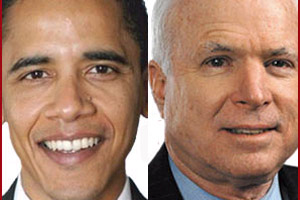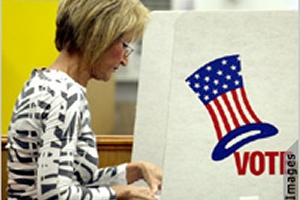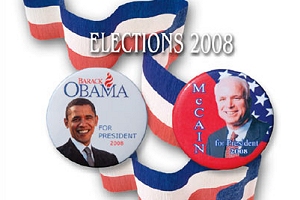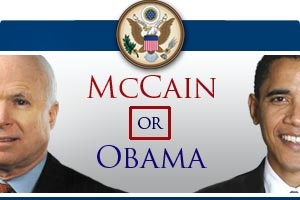America in context
Population Changes Likely to Influence U.S. Election

In 2008 the U.S. electorate is younger, better educated and more diverse than it was when the nation first elected President Bush in 2000, and these population shifts will affect the November 4 election and help shape America’s future political landscape, analysts say.
In 2008 the U.S. electorate is younger, better educated and more diverse than it was when the nation first elected President Bush in 2000, and these population shifts will affect the November 4 election and help shape America’s future political landscape, analysts say.
A large turnout by African Americans, Latinos and young voters is likely to help the Democrats in 2008, but observers also point out that Republicans could benefit from the growth in an important part of their constituency, evangelical Protestants, who now constitute 26 percent of the total population.
African Americans, who now make up 14 percent of the U.S. population, are clearly galvanized by the candidacy of Barack Obama and participated in primaries and caucuses in historically high numbers. Many voter registration drives during 2008 targeted black voters.
This election could be “the year in which African-American enthusiasm [for Obama] is translated into a massive surge in turnout,” said William Galston, a political theorist and senior fellow at the Brookings Institution in Washington and a speaker at an October 20 Brookings forum on demographic trends and the upcoming election. (See “Presidential Campaigns Try to Garner African-American Voters.”)
The growing Hispanic population is another key demographic. Demographer William Frey, a senior fellow at the Brookings Institution, noted that Hispanics accounted for more than half the overall population growth in the United States between 2000 and 2008.
Hispanics, who make up 15 percent of the population, are now the most populous U.S. minority group. By 2042, minorities are projected to total more than half of the U.S. population. (See “U.S. Minorities Will Be the Majority by 2042, Census Bureau Says.”)
Many Hispanics in the United States are not citizens or are too young to vote, and Hispanics historically have had a lower voter turnout than white voters, Frey said, but the Latino vote will be important in some swing states in 2008.
“The places where [minorities] are likely to have the most impact are places I call fast-growing purple states,” such as Colorado, Florida and Virginia, Frey said. He used “purple” as a reference to states where the vote could go for either the Republican or Democratic presidential candidate. In American political shorthand, states that tend to vote Republican are red and those that tend to vote Democratic are blue.
“Over half of the growth in most of [the purple states] is coming from minorities, especially Hispanics,” Frey said, adding that minority voters “are going to be big players” in those states. (See “Obama, McCain Compete in Wooing Hispanic Voters.”)
Some other political observers agree, including the Wall Street Journal’s MarketWatch.com, which said, “The anticipated record-breaking turnout of at least 9.2 million Hispanic voters could be key to winning swing states such as New Mexico, Nevada and Colorado.” There were approximately 7 million Hispanic voters in 2004, and 6 million in 2000.
It also cited polls showing Democrat Barack Obama leading Republican John McCain 65 percent to 30 percent nationally among Latinos. That edge in the Latino vote helps Obama hold a narrow lead in New Mexico, according to the article.
Frey pointed out that Hispanics are not a monolithic group of voters. For example, Cuban Americans tend to vote Republican and Mexican Americans tend to vote Democratic.
However, a commentator on MSNBC.com suggested that “the increased numbers of non-Cuban Hispanics in Florida, as well as the growing Hispanic population in North Carolina and Virginia, could be the tipping voting group [for Obama] in those three states.”
DEMOGRAPHIC CHANGES LIKELY TO PROMPT POLITICAL REALIGNMENTS
Ruy Teixeira, a visiting fellow at the Brookings Institution and editor of a new book, Red, Blue, and Purple America: The Future of Election Demographics, told the October 20 forum that the political alignments of red and blue states could change in the next decade or two as American society changes.
In addition to the growth of minority populations, particularly Hispanic and Asian-American, Teixeira cited several other trends:
• The exceptionally fast growth of populations in the suburbs and exurbs. In 2004, Bush won by substantial margins in growing exurban and rural areas. However, Republican dominance of the suburbs is waning as suburbs become more diverse and more densely populated.
• The shrinking population of the white working class — workers who lack a four-year college degree — and an increase in the number of Americans in the upper middle class. Bush carried the white working class in 2004, but polls show that Democrats are gaining ground there, in part because of concerns about the economy. White college graduates, while still mostly Republican, are “moving kind of smartly in the direction of the Democrats,” Teixeira said.
• The number of evangelical Protestants is increasing, but so are the ranks of people not affiliated with a religion. This latter “secular” group makes up 16 percent of the total U.S. population, jumping to 25 percent of adults ages 18-29. Religiously unaffiliated voters tend to vote Democratic. In 2004, the more religiously observant groups turned out heavily for Bush. Yet in 2006, according to Red, Blue, and Purple, “the electorate didn't break down as clearly along religious lines.” (See “U.S. Religious Landscape Is Marked by Diversity and Change.”)
• The youngest generation of U.S. voters is the nation’s most diverse. “This group of voters is much more receptive to the Democratic Party’s messages, which tend to be more liberal or tolerant,” and they are “much more open” to the idea of a president who is biracial, said Scott Keeter, of the Pew Research Center, at the forum. “I’m pretty confident that young voters are going to go heavily for Obama, and I am confident that they are going to turn out at a relatively high rate.” (See “‘Youthquake’ Expected in 2008 U.S. Election.”)
• The number of households with children is declining, while the number of single and alternative households is increasing. Married voters, especially with children, typically vote solidly Republican, but their representation in the national electorate is waning, according to Red, Blue, and Purple.
• The increasing tendency of Americans to live in communities where others share their cultural and political beliefs. In 2004, 48 percent of voters lived in “landslide counties” — counties where the winning presidential candidate won by 20 percentage points or more.
But one issue is likely to bridge cultural and ethnic divides in 2008. Current polls indicate that the economy is “the top issue for all racial groups: Hispanics, blacks, Asians and whites,” Frey said.
By Louise Fenner
Staff Writer
Recently on America in context
U.S. Democracy Has Come a Long Way
 America's Founding Fathers would be "astounded" to see the presidential race of 2008, James Glassman, under secretary of state for public diplomacy and public affairs, said October 27.
America's Founding Fathers would be "astounded" to see the presidential race of 2008, James Glassman, under secretary of state for public diplomacy and public affairs, said October 27.
The Candidates
 Every presidential campaign is dramatic and historic, but as the fervor surrounding the 2008 election continues to build, U.S. voters and the rest of the world will want to consider the candidates' personal histories more closely. What sort of people rise to the top in the U.S. political system, what are their attributes, their sensibilities, and their strengths?
Every presidential campaign is dramatic and historic, but as the fervor surrounding the 2008 election continues to build, U.S. voters and the rest of the world will want to consider the candidates' personal histories more closely. What sort of people rise to the top in the U.S. political system, what are their attributes, their sensibilities, and their strengths?
Large Audiences Expected for Televised Presidential Debates
 McCain, Obama will participate in three debates, beginning September 26. Polls show the presidential contest between John McCain and Barack Obama is extremely close, but upcoming debates could change that, political experts say.
McCain, Obama will participate in three debates, beginning September 26. Polls show the presidential contest between John McCain and Barack Obama is extremely close, but upcoming debates could change that, political experts say.